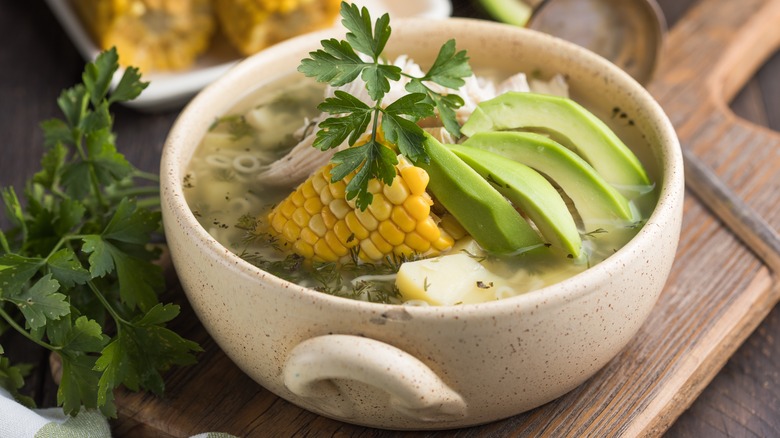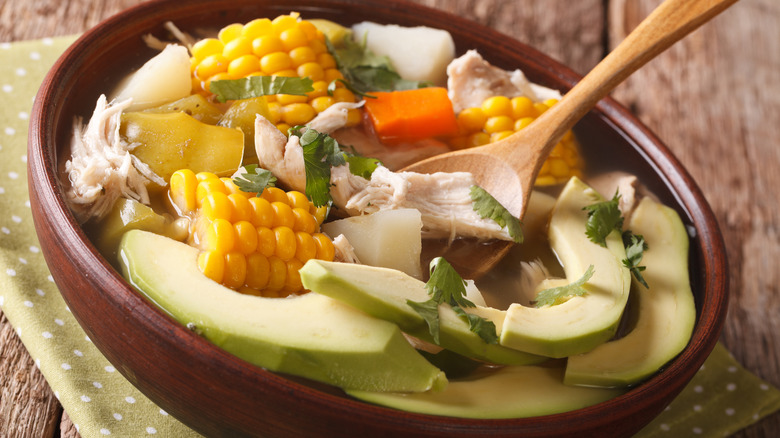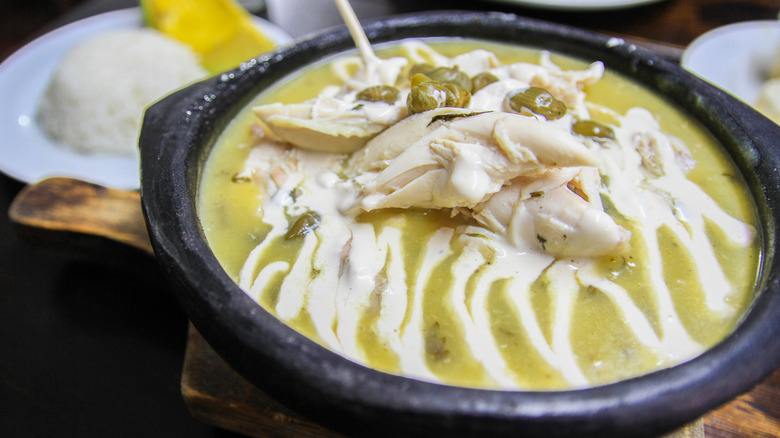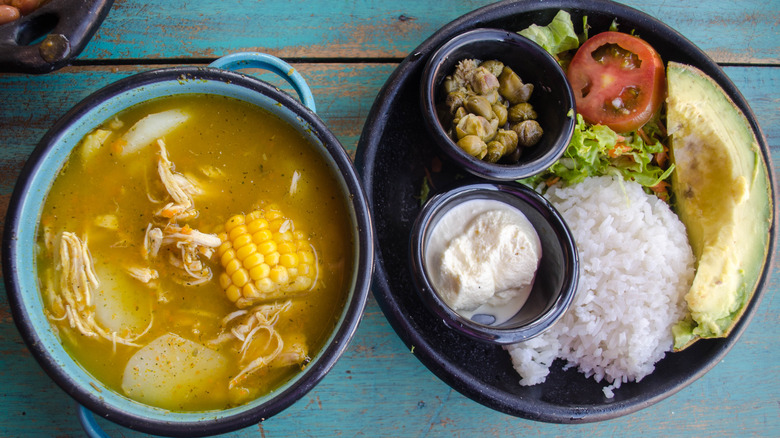Ajiaco: Colombia's Hearty Chicken Soup Packed With Vegetables
The South American country of Colombia is synonymous with coffee for most people. But, what you may not know is that potatoes are also a big chunk of Colombia's agrarian economy. Cultivated first by the Incans as early as 1,800 years ago, South Americans lay claim to the nightshade's beginnings, and the Spaniards brought them back to Spain in the 16th century. So, you can thank equatorial countries like Colombia for tapas such as croquetas de bacalao and tortilla de betanzos.
We're not talking just the brown bakers you may know. From varieties such as papas pastusa which are used for soups and creams, to the widely known papa criolla because of its versatility, the Colombian larder is filled with potatoes. They show up in everything from empanadas to calentao -– a breakfast made of leftovers such as meat, rice, and potatoes. But, there's one dish packing a true Colombian pedigree that you'll want to make time and again –- ajiaco.
The history of ajiaco
Pronounced "ah-hyah-koh," this potato-based soup's origin has been long debated. It is thought by many to come from the Arawakan-speaking Caribbean Taíno tribe –- some of the first inhabitants that Christopher Columbus encountered while "discovering" the new world. It's actually popular throughout Latin America but predominantly in Colombia, Peru, and Cuba
Documented as part of the Cuban diet as early as the 16th century, Amigo Foods notes that the soup's Cuban lineage dates longer than Colombia and Peru, where it was once thought to originate. Whereas the phrase "aji ” is rooted in the Taino language and means "hot pepper" in Spanish. The Taíno people eventually called South America home over the course of about 4,000 years.
Locals lay claim to the indigenous Chibcha people of Cundinamarca, who lived in what is now known as Bogotá –- the capital city of Colombia. These indigenous people ate a creamy corn-based soup that was flavored with "aji ” potatoes that are believed to have been revised by the Spaniards into what is known as today's ajiaco.
But, no matter where it originated, you can bet that potatoes were front and center. Of course, there's more to ajiaco than potatoes.
Ajiaco's ingredients
Cuban ajiaco features pork, chicken, or beef, along with potatoes and vegetables. Whereas the Peruvian style ajiaco starts with potatoes cooked with garlic along with dried peppers and mint.
When it comes to Colombian ajiaco, several ingredients make this staple unique. First of all, not any potato will do. A traditional Colombian version of the soup starts with three types of potatoes – criolla, sabanera, and pastusa. Chicken is a must, as well as guasca leaves. The guasca plant is part of the Asteraceae family, which also includes sunflowers and daisies. Traditionally used as an Andean medicine, guasca is most known as a component of many Colombian dishes. Because of its slight minty yet savory profile, guasca shows up in other Colombian recipes for soups, stews, and drinks. Throw in some corn on the cob, cream, and capers, and you can stop there for the Colombian soup. However, it's most commonly served with a side of rice and sliced avocado.
Where is it served?
Throughout Colombia, variations of ajiaco could be found. Yet, it is mostly connected with the capital city of Bogotá. Because this mountainous region can get chilly, ajiaco is considered a favorite comfort food.
If you travel to Bogotá, there are a myriad of venues to grab a bowl of this soul-warming soup. You can hit up the oldest restaurant in the city, dating to 1816, La Puerta Falsa, for traditional ajiaco. Other Bogotá restaurants that are known for their renditions are Club Colombia and Casa Vieja.
But, if you can't make it to South America, most any Colombian community in the United States is likely to serve the honored tradition. From El Balcon de las Americas in Deerfield, Florida, to Sabor Colombiano in Los Angeles, California, ask for it by name, and you'll find yourself on the forever hunt for guasca leaves so that you can make it anytime you want.



